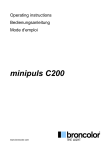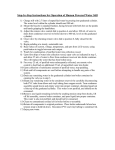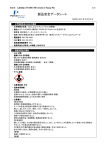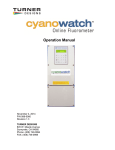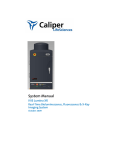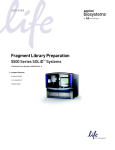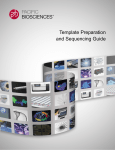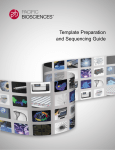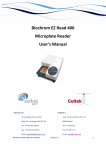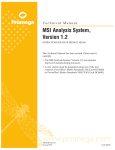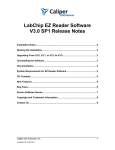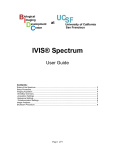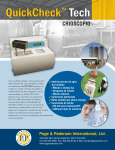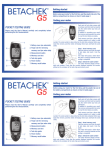Download HISTORY OF REVISIONS:
Transcript
LabChip XT DNA 750 Ver. 2 Kit, Assay User Guide Table of Contents INTRODUCTION .......................................................................................................................................................... 2 APPLICATIONS ..........................................................................................................................................................2 FEATURES ................................................................................................................................................................3 SPECIFICATIONS .......................................................................................................................................................3 KIT CONTENTS .........................................................................................................................................................4 ADDITIONAL ITEMS REQUIRED ...................................................................................................................................4 SAFETY W ARNING & PRECAUTIONS ...........................................................................................................................4 SAMPLE PREPARATION PROCEDURE ................................................................................................................... 5 CREATE LABCHIP RUN FILE .................................................................................................................................... 5 PREPARE XT DNA CHIP ............................................................................................................................................ 7 STARTING THE LABCHIP XT .................................................................................................................................... 7 ANALYZING DATA ...................................................................................................................................................... 8 TYPICAL RESULTS..................................................................................................................................................... 8 CHIP WELL ASPIRATION USING A VACUUM OR MANUAL PIPETTE ................................................................ 20 OPENING CHIP CONTAINER MANUALLY .............................................................................................................. 21 OPENING CHIP CONTAINER WITH OPTIONAL LID OPENER .............................................................................. 21 REORDERING INFORMATION ................................................................................................................................. 22 TECHNICAL SUPPORT ............................................................................................................................................ 22 Caliper- a PerkinElmer company 68 Elm Street Hopkinton, MA 01748-1668 1-877-LABCHIP (1-877-522-2447) Page 1 of 22 PN: CLS135241 Rev 01 LabChip XT DNA 750 Ver. 2 Kit, Assay User Guide Introduction Applications Sizing nucleic acid fragments is a time consuming, but critical part of many library construction protocols. Traditional, gel-based methods are notoriously inefficient and introduce variability that can negatively impact data quality. For paired-end and mate pair libraries, accurate size selection is critical, and improves assembly and facilitates the detection of structural variation. Non-sized libraries can be more difficult to assemble and often have errors in the detection of insertion and deletion events. Accurate sizing is also critical for removing artifacts introduced during the library construction process, such as adapter dimers. Separating fragments containing library from no insert fragments significantly improves the amount of data obtained from the sequencing reaction. The benefits of accurate and tight size selection include improved assembly of the sequenced data, less “non-align” reads, and increased average read length. The LabChip XT/XTe fractionation system performs fast, automated nucleic acid sizing accurately and reproducibly. The XT/XTe replaces the traditional gel method and tightly sizes up to four samples in 20-60 minutes. Manual methods introduce run-to-run variability, resulting in less accurate sizing and variable collection widths. The LabChip XT/XTe provides improved collection efficiency (> 70%) and superior sensitivity, detecting less than 25ng of sheared sample. Fractionated samples are delivered in a sequencing compatible buffer. The XT improves laboratory efficiency and provides a level of sizing accuracy that is difficult to obtain using manual methods. Data is displayed digitally and non-fractionated sample can be recollected and used at another time. Caliper- a PerkinElmer company 68 Elm Street Hopkinton, MA 01748-1668 1-877-LABCHIP (1-877-522-2447) Page 2 of 22 PN: CLS135241 Rev 01 LabChip XT DNA 750 Ver. 2 Kit, Assay User Guide Features Fast separation time – separate up to 300bp in 25 minutes or less. Eliminates slab gels and manual excision to size select DNA. Automated sizing and quantitative information in a digital format. Included reagent set provides predictable, reproducible results. Resulting sample is tightly sized and is delivered in a sequencing compatible buffer. Size Selection may be performed using a software ladder, thus maximizing throughput. Each run can utilize 1-4 channels. Channel Operation Modes: Disabled, Ladder, eXtract and Stop, eXtract and Continue, eXcLuDe Region (XT only), Separation (XT only), eXtract and Pause, or Skip Extraction (XT only). Extraction Modes: size, fluorescence (XT only), peak start, peak max (XT only), smear max (XT only), or collect on click. Specifications LabChip XT DNA 750 version 2 DNA size range 50 to 1000 bp Minimum size distribution as expressed by CV 5% at 300 bp Maximum load capacity 1 µg of sheared genomic DNA, 50ng per fragment Minimum load capacity for optical detection 25ng sheared genomic DNA, 0.5ng per fragment Sample Recovery >75% average recovery Time to 300 bp Time to 750 bp Sizing accuracy <25 minutes <40 minutes 3 +/- 10% 1 2 1 2 3 See FAQ #11 on page 15, See FAQ #13 on page 16, See FAQ #14 on page 16 Caliper- a PerkinElmer company 68 Elm Street Hopkinton, MA 01748-1668 1-877-LABCHIP (1-877-522-2447) Page 3 of 22 PN: CLS135241 Rev 01 LabChip XT DNA 750 Ver. 2 Kit, Assay User Guide Kit Contents LabChip XT DNA 750 version 2 Assay Kit: part number 760656 Box 1 XT DNA 1K Ladder (yellow vial) XT DNA 6x Sample Buffer (green vial) XT DNA Collection Buffer, ver. 2 (red vial) XT DNA Stacking Buffer (purple vial) Store at 4ºC Box 2 LabChip XT DNA 750 ver. 2 Chip Kit (5 Chips) Store between 18-28ºC Additional Items Required LabChip XT/XTe instrument with LabChip XT software version 2.1 or greater may be downloaded from http://www.caliperls.com/support/software-downloads.htm Buffer for dilution of ladder: EB (10mM Tris-HCl; pH 8-8.5) or TE Buffer (10mM Tris-HCl, 1mM EDTA; pH 8-8.5) Microcentrifuge tubes for sample preparation Safety Warning & Precautions ! WARNING! For Research Use Only. Not recommended or intended for diagnosis of disease in humans or animals. Do not use internally or externally in humans or animals. CAUTION We recommend that this product and components be handled only by those who have been trained in laboratory techniques and that it is used in accordance with the principles of good laboratory practice. As all chemicals should be considered as potentially hazardous, it is advisable when handling chemical reagents to wear suitable protective clothing, such as laboratory overalls, safety glasses, and gloves. Care should be taken to avoid contact with skin or eyes. In case of contact with skin or eyes, wash immediately with water. Caliper- a PerkinElmer company 68 Elm Street Hopkinton, MA 01748-1668 1-877-LABCHIP (1-877-522-2447) Page 4 of 22 PN: CLS135241 Rev 01 LabChip XT DNA 750 Ver. 2 Kit, Assay User Guide Sample Preparation Procedure The sample can be prepared up to 1 hour in advance of chip run, either before or after the creation of the run file. Caution: 6x Sample Buffer is light sensitive. Care should be taken to reduce light exposure of prepared sample. 1. Allow Reagent Kit to equilibrate to room temperature before use (approximately 20 to 30 minutes). 2. Ladder preparation, (final = 12µL total) a. Dilute 2µL of ladder ( ) with 8µL of EB or TE Buffer (Use the same diluent as the sample buffer). b. Add 2µL of 6X Sample Buffer ( ). c. Vortex sample to mix. Spin down. 3. DNA Sample preparation, (final = 12µL total) a. If necessary, adjust volume of DNA sample to 10µL by diluting with EB or TE. b. Mix 10µL of DNA sample with 2µL of 6X Sample buffer ( ). c. Vortex sample to mix. Spin down. Create LabChip Run File This step can be prepared in advance of sample preparation and chip preparation. The creation of the run file is not time sensitive. 1. Launch LabChip XT/XTe software. On the LabChip XT/XTe Main Window, select Tools →Run File Editor. The Run File Editor window opens. 2. Select the Method (XT DNA 750 ver.2) to edit from the Fractionation Method drop down list. 3. Under the Setup Tab, type the desired name for each channel in the Sample Name box. 4. For each channel, select the desired operation for the channel using the pull-down menu. Refer to the XT/XTe Instrument Manual for operations modes available for your instrument. a. Disabled - The channel will not be used in the run. Any channel that has already been used is automatically set to Disabled and cannot be reused. b. Ladder - The channel contains a ladder that is used to calculate the sizes in the samples in the remaining channels during the run. c. eXtract and Stop - The sample in the channel will run until the extraction is complete. After the extraction, no additional sample will move through the channel. d. eXtract and Continue - The sample in the channel will run until the end of the chip range. The size range specified in the Extraction Region will be collected in the collection well. e. eXcLuDe Region - The sample in the channel will be collected in the waste well on the chip except for the selected region, which moves into the collection well on the chip. The desired output is extracted from the waste well. f. Separation - The sample in the channel will run until the end of the chip range. No collection will occur. g. eXtract and Pause - Used for multiple extractions, the sample in the channel will be collected in the collection well and the run will pause for collection before resuming the run. h. Skip Extraction - Skips over a known region in the sample without extracting any sample to the Collection well. The software automatically moves to the next step in a multistep extraction immediately after the skipped region is complete. When used for multiple extractions, the first step of the extraction is set to Skip Extraction, typically using Peak Max as the extraction mode. The software will automatically identify the peak within the Search Region, and prevent the next step from triggering through the size range designated by the Caliper- a PerkinElmer company 68 Elm Street Hopkinton, MA 01748-1668 1-877-LABCHIP (1-877-522-2447) Page 5 of 22 PN: CLS135241 Rev 01 LabChip XT DNA 750 Ver. 2 Kit, Assay User Guide 5. 6. 7. 8. Collection Width. The peak identified in the Skip Extraction step will be marked in grey on the Electropherogram. The second step, typically Extract and Pause for the peak of interest, may be set with an overlapping Search Region. For each channel, select desired extraction mode using the radio buttons. With the exception of Size Range, the collection Width can be specified as the total number of base pairs (BP), a percent of the size at which extraction is centered (+/-%), or can be trigger by a Manual click. a. Size Range - The specified size range will be diverted to the chip collection well. Size range can be specified on the Setup Tab as a Size a percent of the size, or on the Advanced Tab as a specific start and end size in the Extraction Region text boxes. The Setup Tab and Advanced Tab are synchronized to always specify the same settings. b. Fluorescence – Collection begins when the specified fluorescence Threshold, in RFU, is exceeded. c. Peak Start – Collection begins at the start of a peak, when the specified slope Threshold, in RFU/minute, is exceeded. d. Peak Max – Collection is centered on the first local maximum in the specified region. The signal slope within the search region must exceed the specified slope threshold (RFU/min) to arm this trigger. The extraction is triggered when the signal has switched to a negative slope which meets or exceeds the specified threshold in magnitude. If the end of the search region is reached after the trigger has been armed but before the negative slope threshold has been achieved, the extraction will trigger at the end of the search region. e. Collect On Click – Collection is initiated by the user. To select the highlighted region, click on the word CLICK in the Run Setup section on the left side of the LabChip XT Main Window. A dialog window will prompt you to confirm or cancel, and the target region will continue to update until confirmed. Note that for some width settings, the target region may extend past the last visible data point on the graph. In this case, the highlighted region will end at the last visible data point and the dialog box will indicate at what time the target region ends. When manual mode is selected in the width setting, click on the word STOP in the Run Setup section to end the collection or exclusion. f. Smear Max - In Smear Max mode, the software will search within the specified region for the point at which two consecutive conditions have been met: 1) the signal has reached or surpassed the specified threshold signal (RFU) and 2) the signal is decreasing after averaging over three consecutive data points. For XT only, click the Sizing Table Tab in the Run File Editor window. a. To use the default Caliper ladder, select the Method Ladder option. b. To use a custom ladder by specifying the sizes of the peaks in the ladder, select the Custom Ladder option and type the ladder peak sizes into the size column of the ladder table. Click on Output tab and confirm Data Path and input the File Prefix/Project Name. Click the Save button and save the created run file to the desired directory. Caliper- a PerkinElmer company 68 Elm Street Hopkinton, MA 01748-1668 1-877-LABCHIP (1-877-522-2447) Page 6 of 22 PN: CLS135241 Rev 01 LabChip XT DNA 750 Ver. 2 Kit, Assay User Guide Prepare XT DNA Chip The LabChip XT750 Rev 2 chip contains a light sensitive dye. The chip should be protected from light prior to use. Steps 1-5 should immediately be followed by steps 6-8. 1. Remove Chip from foil bag and peel back top seal from chip. 2. Gently remove Sample Well and Collection Well combs. 3. If gel or buffer is present in either the sample or collection wells, it should be manually removed before sample loading. See “Chip Well Aspiration Using a Vacuum or Manual Pipette” at end of User Guide for illustrations. 4. If a well fills with buffer after vacuuming, do not use that channel. 5. Ensure the top surface of the chip is dry. SAMPLE WELL SOURCE WASTE RESERVOIR RESERVOIR COLLECTION WELL Steps 6-8 are time-sensitive steps. The run should be started within 5 minutes to prevent diffusion of loaded DNA sample and stacking buffer. 6. Add 20µL of the Collection Buffer to round Collection Wells ( ). 7. Add 30µL of the Stacking Buffer to rectangular Sample Wells ( ). Ensure that no bubbles remain in the well before proceeding to the next step. 8. Load the entire 12µL of the sample or prepared ladder into Sample Wells by layering under the Stacking Buffer. Position the pipette so that the tip gently touches but is not sealed against the bottom of the well. Pipette sample very slowly (510 secs to dispense). The goal is to place the sample at the bottom of the well and to avoid mixing the sample with the stacking buffer. For best results, start the XT run within 5 minutes of loading the samples into the wells of the chip. Starting the LabChip XT 1. Place the chip in the LabChip XT instrument with the positioning feature in the upper left corner aligning with the corresponding pattern on the instrument. 2. Close lid and select Instrument -> Start Run (or move the mouse over the instrument icon and click on the green run arrow). 3. To import the settings from a previously saved run file, click the Import Settings button at the bottom of the Start Fractionation window. 4. Select the desired run file, click the Open button and then click the Run button. 5. See LabChip XT User Manual or Run File Guide for more details on run parameter selection. Collect Fractionated Material For multiple extractions: During the pause after each collection, open the LabChip XT instrument lid and pipette recovered DNA sample ( ) from each collection well into a clean tube for downstream processing. If necessary, wash well with 20µL collection buffer and add 20µL buffer for next collection. Close lid and click Resume. For single extractions: After run has completed, open the LabChip XT Caliper- a PerkinElmer company 68 Elm Street Hopkinton, MA 01748-1668 1-877-LABCHIP (1-877-522-2447) Page 7 of 22 PN: CLS135241 Rev 01 LabChip XT DNA 750 Ver. 2 Kit, Assay User Guide instrument lid and pipette recovered DNA sample ( downstream processing. ) from each collection well into a clean tube for Analyzing Data Refer to the LabChip XT User Manual for Data Analysis. Typical Results Example 1: Ladder and 3 channels with DNA with 1000ng mass input and size selection at 500bp (eXtract and Pause mode) 1. 2. 3. 4. Channel 1: Caliper 1K sizing ladder Channel 2: 1000ng input, select by size range: 500bp +/-4% (red) Channel 3: 1000ng input, select by size range: 500bp +/-4% (blue) Channel 4: 1000ng input, select by size range: 500bp +/-4% (green) Figure 1A. LabChip XT Electropherogram Caliper- a PerkinElmer company 68 Elm Street Hopkinton, MA 01748-1668 1-877-LABCHIP (1-877-522-2447) Figure 1B. Electropherogram of collected material Page 8 of 22 PN: CLS135241 Rev 01 LabChip XT DNA 750 Ver. 2 Kit, Assay User Guide Example 3: Ladder reproducibility within three chips (separation only mode) 220ng of ladder in each channel Figure 3A: LabChip XT Electropherogram Caliper- a PerkinElmer company 68 Elm Street Hopkinton, MA 01748-1668 1-877-LABCHIP (1-877-522-2447) Figure 3B: Migration Variation over three chips Page 9 of 22 PN: CLS135241 Rev 01 LabChip XT DNA 750 Ver. 2 Kit, Assay User Guide Example 6: Extractions of Fragments at 50 bp (eXtract and Pause mode) with Ladder and 3 channels with DNA fragments at 0.5ng, 5ng and 50ng mass input 1. 2. 3. 4. Channel 1: Caliper 1K sizing ladder Channel 2: 0.5ng input, select by peak max, threshold=25RFU/min, 50bp +/-8% Channel 3: 5ng input, select by peak max, threshold-50RFU/min, 50bp +/-8% Channel 4: 50ng input, select by peak max, threshold=100RFU/min, 50bp +/-8% 0.5 ng fragment Lower marker Collected peak Collected peak Collected peak Lower marker Lower marker Caliper- a PerkinElmer company 68 Elm Street Hopkinton, MA 01748-1668 1-877-LABCHIP (1-877-522-2447) Page 10 of 22 PN: CLS135241 Rev 01 LabChip XT DNA 750 Ver. 2 Kit, Assay User Guide Troubleshooting 1. Chip fails connectivity test. Once a chip has failed a connectivity test, record which channel has failed. Remove the chip from the instrument. o Check that the outlets leading from the chip to the buffer reservoirs are not blocked by an air bubble. Air bubbles may be dislodged by gently tapping the chip near the location of the air bubble. o Check to see that the correct amount of collection buffer and stacking buffer/sample have been added to their respective wells. Collection buffer is required in all channels used, even if no collection will take place. o Check to see that the surface of the chip, the electrical contacts and the underside of the instrument lid are free of buffer or adhesive residue. If any buffer or residue is found, remove buffer before beginning run again. If it is observed that the reservoirs do not have sufficient levels of buffer to cover the chip electrodes, the chip is defective; please contact Technical Support for chip replacement. o Check to see that the spring-loaded electrical contacts on the lid are not stuck. Salt deposits may cause the contacts to stick. Clean contacts and press down on pins to reposition to full length. o Note: if directed by Caliper Technical Support, it is possible to run the connectivity test separate from starting a chip run. See the description of the Test Chip button on the Start Fractionation Window in the LabChip XT User Manual. 2. Lower Marker (LM) was not detected. An internal standard (LM) is added to samples to assist in determining size and concentration of the sample. The marker is also the first peak in the ladder. The lower marker is contained in the XT DNA 6x Sample Buffer (green vial). o If the lower marker is not detected, the marker might have degraded over time due to exposure to light. Repeat run again with fresh vial of 6x Sample Buffer. o A second possibility is that insufficient amount of 6x Sample Buffer was added to the sample. Ensure that the pipette is accurately dispensing 2µL of XT DNA 6x Sample Buffer and doing so evenly to all channels. 3. Ladder was not detected or peaks were very low. Check that the optical windows on the XT instrument are not blocked or contaminated with any potentially fluorescent material, such as paper dust, dyes, reagents, or materials that may block light. Contaminants must be removed before starting a run. Dust can be removed with pressurized and filtered air. If using a disposable pressurized air can, hold the can upright to avoid spraying propellant onto the optics. Use a lint free wipe or swab dampened with de-ionized water to rinse the chip locator. Allow all dampened surfaces to air dry. Do not use detergents or other cleaners, as they may contain fluorescent dyes that interfere with the run. Sample may not have been properly loaded into the sample well. If there are unused channels on the chip, repeat ladder load on a different channel and if the problem persists, repeat with a fresh vial of ladder. Ensure that the sample diluent used with the DNA ladder (2µL 6x Sample buffer + 2µL ladder + 8µL sample diluent) does not contain high amounts of salt. This will reduce the stacking of DNA during separation. The recommended sample diluent is TE or EB; pH 8.0-8.5. Caliper- a PerkinElmer company 68 Elm Street Hopkinton, MA 01748-1668 1-877-LABCHIP (1-877-522-2447) Page 11 of 22 PN: CLS135241 Rev 01 LabChip XT DNA 750 Ver. 2 Kit, Assay User Guide 4. Ladder peaks are too broad. Broad or non-Gaussian ladder peaks are most commonly the result of poor sample loading. Ensure that the DNA sample is not being mixed with stacking buffer and that the sample is being loaded as described in step 12 of the section “Prepare XT DNA Chip” above. Gel in the sample well (incomplete removal by the combs) can also cause broad ladder peaks. Ensure that all agarose has been removed from the sample wells without disrupting the gel in the channel. See “Chip Well Aspiration Using a Vacuum or Manual Pipette” at the end of this guide. Ensure that the stacking buffer (pink vial) was used in the sample well and not another reagent. Without the stacking buffer, the peaks will appear broad. Ensure that the sample diluent being used with the DNA ladder (2µL 6x Sample buffer + 2µL ladder + 8µL sample diluent) does not contain high amounts of salt. This will reduce the stacking of DNA during separation. The recommended sample diluent is EB or TE, pH 8.0-8.5. 5. Ladder has double peaks. Sample may not have been properly loaded into the sample well or there may have been excessive gel in the sample well. Ensure that all agarose has been removed from the sample wells without disrupting the gel in the main channel. See “Chip Well Aspiration Using a Vacuum or Manual Pipette” at the end of this guide. If there are unused channels on the chip, repeat ladder load on a different channel and if the problem persists, repeat run again with fresh vial of ladder. Ensure that the sample diluent being used with the DNA ladder (2µL 6x Sample buffer + 2µL ladder + 8µL sample diluent) does not contain high amounts of salt. This will reduce the stacking of DNA during separation. The recommended sample diluent is EB or TE; pH 8.0-8.5. 6. During the run, the ladder peaks broaden or slow down in migration. Check that there is a sufficient amount of buffer in the reservoirs. Reduced buffer volume will reduce the buffer capacity of the chip. Check for buffer on the surface of the chip which may create a short between electrodes. Ensure that the sample diluent used in the ladder does not contain high amounts of salt which can affect DNA migration and stacking. Ensure that the full 30µL of stacking buffer was added to the sample well. If insufficient amounts of stacking buffer are added, the sample well may dry out during the run. 7. Size selected material was too large or too small. Ensure that the sample well has not been overloaded with DNA. To achieve the specified sizing accuracy, the sample load should not exceed 1000ng of sheared DNA as over-sizing can occur with overloading. High amounts of salt can affect DNA migration and stacking, which may lead to inaccurate sizing. The sample is recommended to be in EB or TE; pH 8.0-8.5. 8. Size selected material has shoulder on leading edge or trailing tail of peak when size selected material has been analyzed by LabChip microfluidic separation or BioAnalyzer instruments. Shoulders or tails (non-Gaussian behavior) can occur when samples are not loaded properly. Ensure that the DNA sample is not being mixed with stacking buffer and that the sample is being loaded as described in step 12 of the section “Prepare XT DNA Chip” above. There are other possible causes for the appearance of shoulders, tails, and secondary peaks, many of which will not impact sequencing results. Among them are the following: the presence of DNA secondary structure in the DNA, the presence of ligases or other proteins, PCR over-amplification of template, and the presence of adapters or highly modified adapters which can form hairpins, loops or concatamers. Possible solutions would be heating followed by slow cooling of the material to remove secondary structures, the optimization of the PCR cycle number, or the use of other adapter designs. Caliper- a PerkinElmer company 68 Elm Street Hopkinton, MA 01748-1668 1-877-LABCHIP (1-877-522-2447) Page 12 of 22 PN: CLS135241 Rev 01 LabChip XT DNA 750 Ver. 2 Kit, Assay User Guide 9. Fluorescent signal is weak. Check that the optical window on the XT instrument is not blocked or contaminated with any potentially fluorescent material, such as paper dust, dyes, or reagents. Contaminants must be removed before starting a run. Dust can be removed with pressurized and filtered air. To clean spills, use a lint free wipe or swab dampened with 70% - Isopropanol solution in deionized water to clean the lid and chip locator. Run an optics diagnostic test, under the Validation menu. If a channel’s gain is not adequate or background is too high, contact Caliper Technical Support. Check to see that the chip has not expired. 10. Optical detection was saturated during run. Saturation may occur if more DNA is loaded than supported by the assay specifications. Run an optics diagnostic test using the test chip, under the Validation menu. If any diagnostic failures are reported, contact Caliper Technical Support. Please specify the nature of the peak that saturated and what methods were used to quantitate the DNA fragments or smears.. 11. Collection well was empty after run. Ensure that the specified amount of Collection Buffer was added to the collection well before the run has started. Chip may have been left on instrument too long and the collected sample may have evaporated. It is important to recover the sample immediately after a run is completed to avoid loss of sample. Laboratory temperature may be too high and the collection buffer is evaporating over the course of the run. Incorrect reagent was used in the collection well. Ensure that the collection buffer (red vial) was used. 12. Top of chip was wet with buffer after run. Ensure that the top of the chip is dry before beginning the run Buffer may form a liquid bridge in the openings to the buffer reservoirs during shipping and handling. Typically any meniscuses in these openings will break on their own within a few minutes. Occasionally liquid in the meniscus will be transferred to the surface of the chip during a run. Generally this has no impact, but this occurrence can be eliminated by using a pipette tip to remove any meniscus of liquid in the openings to the reservoirs on the top surface of the chip prior to starting the run. Inspect electrodes for buffer. Use a lint free swab dampened with de-ionized water to rinse the electrodes if any buffer contamination is seen. Allow electrodes to air dry before using instrument. 13. Sieving material in chip appears cracked or dislodged after opening from foil packaging. Temperature of the chip may have exceeded optimal recommended temperature during shipment or storage. Wide fluctuations in temperature may affect sieving material integrity. Always keep the chips in their original packaging and at room temperature before use. Foil seal over chip may have been damaged during shipment. If a chip is not sealed properly, fluctuations in pressure may affect sieving material integrity. Any affected channels should not be used. 14. A buffer reservoir is empty after opening foil packaging. The chip is defective, contact Caliper Technical Support. Caliper- a PerkinElmer company 68 Elm Street Hopkinton, MA 01748-1668 1-877-LABCHIP (1-877-522-2447) Page 13 of 22 PN: CLS135241 Rev 01 LabChip XT DNA 750 Ver. 2 Kit, Assay User Guide 15. Well filled up with buffer after comb removal or after excess sieving material was vacuumed from a well. If the sieving material in the channel is disrupted, buffer can continuously flow into the sample or collection well from surrounding reservoirs. This is a symptom of the sieving material having been compromised or dislodged in the channel and can lead to poor resolution. See step 6 in the section “Prepare XT DNA Chip” above. If buffer is flowing into the well, the channel is considered to be compromised and should not be used. If the sample or collection well fills with buffer only after removing of excess gel by vacuum, take care not to form a strong vacuum seal at the bottom of the well, thereby disrupting or possibly removing gel from the channel. Reduce strength of the vacuum. Frequently Asked Questions Kit Specification 1. What is in the Ladder? The XT DNA Ladders are a mixture of individually chromatography-purified double stranded DNA fragments. The ladder is recommended for sizing and approximate quantification of a wide range of double-stranded DNA. The ladder is supplied in Storage Buffer (TE buffer) which is made up of 10 mM Tris-HCl (pH 7.6) and 1 mM EDTA. Ladder data is used to convert the migration time of each sample peak into a size. 2. What happens to the software if the ladder fails to be detected during a run? If the software is unable to detect the real time ladder peaks, it will automatically default to the Caliper method ladder. The method ladder is a virtual historical ladder based on the historical migration performance of the kit ladder provided. 3. What is in the 6xSample Buffer? The 6x Sample Buffer contains the lower marker (first peak in the ladder), DMSO and glycerol. The lower marker is not a nucleic acid and will not interfere with sequencing. Once the 6x Sample Buffer has been mixed with the sample of interest, glycerol increases the density of the DNA sample and ensures that it will load below the stacking buffer. It is imperative that the stacking buffer is not mixed with the DNA sample below to ensure proper stacking of the DNA. 4. What is in the collection buffer and is it compatible with sequencing? The collection buffer is formulated with a Tris-Tricine based buffer that is mixed with a dye and a polymer component which increases extraction efficiency. It is slightly basic in pH (8.3) and is compatible with sequencing and downstream analysis. For Illumina TruSeq library construction, sizeselected sample may be added directly to the following PCR reaction up to 40% of the total PCR volume. 5. What is the shelf life of chips? Initial shipments of the version 2 kit will have a shelf life of 10-16 weeks when shipped to customers. Once sufficient shelf life data is available, chips will be shipped to customers with a shelf life of 4-6 months. with a shelf life of 6 months from the date of manufacture. Customers are guaranteed a shelf life of 4 months from the shipping date. Caliper- a PerkinElmer company 68 Elm Street Hopkinton, MA 01748-1668 1-877-LABCHIP (1-877-522-2447) Page 14 of 22 PN: CLS135241 Rev 01 LabChip XT DNA 750 Ver. 2 Kit, Assay User Guide 6. Why do samples size-selected on the LabChip XT version 2 size differently when analyzed on the Agilent 2100 Bioanalyzer High Sensitivity DNA assay? The Agilent 2100 High Sensitivity DNA assay is very sensitive to the ionic strength and buffer constituents in the sample. When running extractions from the XT 750 version 2 assay directly on the Agilent High Sensitivity assay, the size estimate will be up to ~10% too low for sizes up to 600 bp and up to ~25% too low for sizes greater than 600 bp. An easy workaround for more accurate sizing of XT-extracted samples on the Bioanalyzer is to dilute the Bioanalyzer High Sensitivity ladder 1:1 with the XT version 2 collection buffer (i.e. mix 1 µL of ladder solution with 1 µL of XT collection buffer). To ensure proper ladder peak identification for this workaround, it is also recommended to adjust the peak filter width[s] setting found on the Bioanalyzer software advanced tab from the default 0.8 to 3. Note that the sizing error described above does not occur when running XT-extracted samples directly on the Caliper LabChip GX High Sensitivity DNA assay. In addition, the above workaround is not necessary if the extracted samples are first cleaned (e.g., spin column, beads, etc) prior to analysis on the Bioanalyzer. 7. What is the maximum amount of DNA that can be loaded in each channel? The maximum amount of DNA that can be loaded into one channel is 1µg of sheared DNA (fragmented to a distribution within the kit’s specifications, or 50ng of a single fragment double stranded DNA. Caliper recommends that users quantitate their DNA before loading onto a chip to avoid overloading. 8. What happens if I overload the chip with DNA? Overloading a particular channel with more than 1µg of sheared DNA can result in poor sizing and/or resolution. Loading DNA beyond specifications may lead to under-quantification of the total mass, optical saturation, and an electropherogram that is not representative of the actual population of input DNA. 9. What are the smallest and largest sizes that the XT750 version 2 can recover? The XT DNA 750 version 2 kit can recover DNA sizes centered from 50bp to 1000bp. 10. How can extraction width be measured? For the Gaussian peaks that are typically extracted, the standard deviation of the peak can be described as FWHM*0.425, where FWHM is the full width at the high signal maximum. The CV can then be calculated as the standard deviation divided by the peak size (CV = 0.425*FWHM/size). 11. What is the minimum width that can be collected? An extraction width study was conducted using sheared human genomic DNA, input masses of 1001000 ng and target extraction sizes between 100-750 bp (N=65). The minimum extraction width (measured as a CV) was 5% at 300 bp. The median CV at 100 bp, 300 bp, 500 bp, 750 bp and 1000 bp was 9.6%, 6.1%, 7.0%, 15%, and 21%, respectively. Caliper- a PerkinElmer company 68 Elm Street Hopkinton, MA 01748-1668 1-877-LABCHIP (1-877-522-2447) Page 15 of 22 PN: CLS135241 Rev 01 LabChip XT DNA 750 Ver. 2 Kit, Assay User Guide 12. What is the maximum width setting that can be collected? The maximum recommended width setting for a single extraction is +/-15. Collection widths that exceed +/-15% may result in over-sizing with little increase in the amount of material recovered. Wider ranges can be accommodated using multiple extractions including the Auto MultiStep Cut feature which will automatically set up multiple, back-to-back extractions with optimal extraction widths to cover the desired range. Based on the requirements of the experiment and the nature of the sample, the user can optimize the collection width to ensure the appropriate balance between a tight size selection and an optimal recovery. 13. What are typical recovery rates of sample? Typical recovery rates of DNA sample are 50%-90% when using the eXtract and Stop or eXtract and Pause mode. In a recovery efficiency study using 50 bp, 300 bp and 700 bp fragments of known masses 0.5 ng, 5 ng and 50 ng, the median recovery rate was 79%, the lowest measured recovery rate was 41%, and 94% (15/16) of the collections had a recovery rate greater than 50%. 14. What is the typical sizing accuracy? A sizing accuracy study was conducted using sheared human genomic DNA, input masses of 100-1000 ng and target extraction sizes between 100-750 bp (N=65). Approximately 80% of the extractions had a sizing error within +/-10%. 100% of the extractions were within +/-20%. Note that the measurement method can contribute significantly to variability and bias in the extraction size measurement (see #6 above). 15. What are the recommended width settings for the tightest peak or the highest recovery? Yes. See below for a table of recommended percent widths. Application Tightest peak from a smear Optimal tradeoff between recovery and tightest peak from a smear Optimal fragment recovery Caliper- a PerkinElmer company 68 Elm Street Hopkinton, MA 01748-1668 1-877-LABCHIP (1-877-522-2447) Page 16 of 22 Size Range 50-1000 Width Setting 4-5% 50-1000 10% 50-300bp 8% >300bp 5% PN: CLS135241 Rev 01 LabChip XT DNA 750 Ver. 2 Kit, Assay User Guide Assay Preparation 1. How long can DNA remain in sample well after being loaded? Caliper recommends to start the run within 5 minutes of sample loading. 2. How long can DNA remain in the collection well after being run? Caliper recommends collecting the sample within 20 minutes end of a run. 3. Can I use my own buffer in the collection well? Caliper does not recommend using alternate chemistries with XT reagents. Standard reagents have been carefully optimized for best performance. 4. Can I use my own dye? Caliper does not recommend using alternate dye chemistries with XT chips and reagents. 5. Can chips or individual channels be reused? Chips and individual channels cannot be re-used. Once a channel has been used, Caliper cannot guarantee that the chip will run properly, have enough buffer capacity, or that there will not be any cross-contamination. The software automatically disables any channel that has previously been used to prevent accidental reuse. 6. How do I maximize recovery of my DNA? The best way to maximize DNA recovery is to stay within kit specifications (do not over-load channel with excess DNA, practice proper sample preparation/chip preparation/DNA loading techniques, and use low salt DNA diluent for maximum stacking). For maximum run speed and collection efficiency, choose the “extract and stop” operation or use “extract and pause” when collecting multiple fractions. 7. What happens when buffer capacity is exceeded? The pH and current will begin to drift when the buffer capacity is exceeded, eventually resulting in poor performance. There is no sudden drop in performance if a software warning is issued. The limits are offered as a guideline that should give the most consistent results. 8. How do I setup multiple extractions? Refer to the LabChip XT Run File Guide. 9. Is a separate chip test required before the actual run? No, a separate chip test is not required but may be performed for troubleshooting purposes (e.g., when instructed by Caliper Technical Support). When running a separate chip test, add running buffer to the sample and collection wells before starting the test. You should not run this test with the sample loaded as the sample will be pushed into the channel during the test. After running the test you should carefully rinse the sample well and remove all liquid before proceeding with the normal chip preparation. Caliper- a PerkinElmer company 68 Elm Street Hopkinton, MA 01748-1668 1-877-LABCHIP (1-877-522-2447) Page 17 of 22 PN: CLS135241 Rev 01 LabChip XT DNA 750 Ver. 2 Kit, Assay User Guide 10. Can I store the chips in the refrigerator to extend shelf-life of chips? No, chips should be stored at room temperature (18-28ºC). 11. Can I load more than 10µL of sample but stay under 1µg per channel? Yes. 15µL of sample per channel may be used with only a slight reduction in performance (wider extractions on average). Loading 15 µL of sample requires 3µL of 6x Sample Buffer per channel loaded (for a total of 18µL). It is important to keep the ratio of the sample buffer to customer sample the same. One can also use 5µL of sample plus 1µL of 6x Sample Buffer without compromising performance. 12. How does one dispose of the chip after use? Users should follow state/local/company/academic regulations for disposal of biohazardous medical wastes. 13. Can I recover sample from the waste reservoir? Yes. DNA left in the waste reservoir can be recovered once a run has been completed. If the DNA is to be recovered from the waste reservoir, it is recommended that the user run an assay for the maximum allowable time (extract and continue or exclude) to ensure that the DNA of interest has had enough time to reach the waste reservoir. There is also a Flush step that can be used to send DNA to the waste well, even if the chip or channel has been used and the run is complete. Standard purification kits can be used to purify DNA from the collected waste reservoir, though it is recommended that column purification be used. 14. I see a scratch on the bottom of the chip. Will this interfere with optical detection? Minor scratches on the bottom surface of the chip will not interfere with optical detection. 15. My background level of fluorescence seems high. Can I clean the optical detection area? Yes. See “Cleaning LabChip XT” in the user manual for a detailed description on how to clean the optical windows on the XT instrument. 16. One channel seems to be running consistently faster than the other channels. Will this affect my size selection? Some variation between channels is normal and migration times are normalized by the lower marker in each channel. Severe and consistent variations may indicate a problem with the instrument. Run the instrument diagnostics and report any failures to Caliper Technical Support. 17. Can I load DNA smear in all four channels and size select without the use of a ladder? Yes, if no channel is designated as a ladder, the software will use the “method ladder” that is supplied with the assay with additional lot specific information coming for the chip barcode. For optimal sizing accuracy when using the size range extraction mode, Caliper recommends using the Caliper supplied ladder. Optically assisted extraction modes often do not require the use of the supplied ladder. Caliper- a PerkinElmer company 68 Elm Street Hopkinton, MA 01748-1668 1-877-LABCHIP (1-877-522-2447) Page 18 of 22 PN: CLS135241 Rev 01 LabChip XT DNA 750 Ver. 2 Kit, Assay User Guide 18. If I don’t use all four channels during a run, can I use the remaining channels later? Yes, but Caliper does not guarantee that the chip will comply with specifications of the kit when it is partially used. It is critical that the chip remains sealed when not in use to prevent drying of the gel matrix. For optimal performance Caliper recommends using all channels at once. Caliper- a PerkinElmer company 68 Elm Street Hopkinton, MA 01748-1668 1-877-LABCHIP (1-877-522-2447) Page 19 of 22 PN: CLS135241 Rev 01 LabChip XT DNA 750 Ver. 2 Kit, Assay User Guide Chip Well Aspiration Using a Vacuum or Manual Pipette Removal of excess gel or buffer from the sample and collection wells can be accomplished by manual pipetting or by attaching a pipette tip to a house vacuum line or vacuum pump with trap (Figures 8A). Attach a pipette tip to the vacuum line and carefully aspirate excess gel. Caliper recommends using a pipette tip with an opening of approximately 1 mm and regulating the vacuum to no more than 20 in Hg to prevent too high a flow rate and possible dislodging of gel in the channel (Figure 8B). During vacuuming, avoid making a tight seal with the pipette tip at the bottom of the sample and collection wells as this could result in the removal of gel from the separation channel. Figure 8B: Attached pipette tip for vacuuming of wells Figure 8A: Vacuum setup To prevent contamination, use a new pipette tip over the permanent tip for each chip aspirated or a new pipet tip with each manual pipette. Ensure the well bottoms are not blocked by gel or buffer before proceeding (Figure 9). Figure 9A: sample well before vacuum Caliper- a PerkinElmer company 68 Elm Street Hopkinton, MA 01748-1668 1-877-LABCHIP (1-877-522-2447) Page 20 of 22 Figure 9B: sample well after vacuum PN: CLS135241 Rev 01 LabChip XT DNA 750 Ver. 2 Kit, Assay User Guide Opening Chip Container Manually To manually open the chip container, first lift tab up until it is in a vertical position. Do not rock the tab back and forth. Next, position the can so that it is held securely in place with the smooth side of the can against your body. The tab should be positioned at 3 o’clock. Pull the lid back until it is detached. Carefully reach in to remove the chips. Opening Chip Container with Optional Lid Opener A lid opener is an optional accessory item (P/N 133524) that can be used to assist in opening of the XT chip containers. To use the lid opener, use the following steps: Step 1: Open handles. Attach lid opener parallel to top of container aligning the two arrows. Be sure the cutting mechanism fits snugly against the side of the can. Close handles. Step 2: Turn knob clockwise. After a full circle around the edge of container, you will feel the resistance drop. Step 3: To release, turn knob slightly counter-clockwise and open handles. Step 4: Use the Lid Gripper (small metal pliers on right side of can opener) to easily lift lid from container. Carefully reach in to remove the chips. Caliper- a PerkinElmer company 68 Elm Street Hopkinton, MA 01748-1668 1-877-LABCHIP (1-877-522-2447) Page 21 of 22 PN: CLS135241 Rev 01 LabChip XT DNA 750 Ver. 2 Kit, Assay User Guide Reordering Information Product Part Number LabChip XT DNA 750 version 2 Assay Kit CLS760656. Technical Support Caliper Life Sciences 68 Elm Street Hopkinton, MA 01748-1668 Phone: 1-877-LABCHIP (522-2447) Fax: 1-508-435-3439 For additional assay and instrument troubleshooting, refer to the LabChip HT Software Help file. Call Caliper Technical Support at 1-877-LABCHIP. The chip and reagents supplied with this kit are sold with limited rights of use. The chip may only be used with the specific quantity of reagents supplied with this kit. The purchaser has no right or license to refurbish, reuse, remanufacture, or otherwise use the chip with any other reagents than those specifically supplied in this kit. For more information on the terms and conditions of use of these chips and reagents, please read your LabChip XT User Guide. Caliper, the Caliper logo, LabChip, and the LabChip logo are registered trademarks of Caliper Life Sciences - a PerkinElmer Company. The purchase of this product conveys to the buyer the non-transferable right to use the purchased amount of the product and components of the product only in research conducted by the buyer (whether the buyer is an academic or for-profit entity), including research services that do not involve the transfer of this product or its components or derivatives thereof. The sale of this product is expressly conditioned on the buyer not using the product or its components (1) in manufacturing or in quality assurance or quality control; (2) for therapeutic, diagnostic or prophylactic purposes; (3) to resell, sell or otherwise transfer this product or its components to any third party, whether or not such product or its components are resold for use in research; or use for any use other than use in research or for any other commercial purpose. © Copyright Caliper Life Sciences – a PerkinElmer Company 2012 http://www.caliperLS.com Caliper- a PerkinElmer company 68 Elm Street Hopkinton, MA 01748-1668 1-877-LABCHIP (1-877-522-2447) Page 22 of 22 PN: CLS135241 Rev 01























